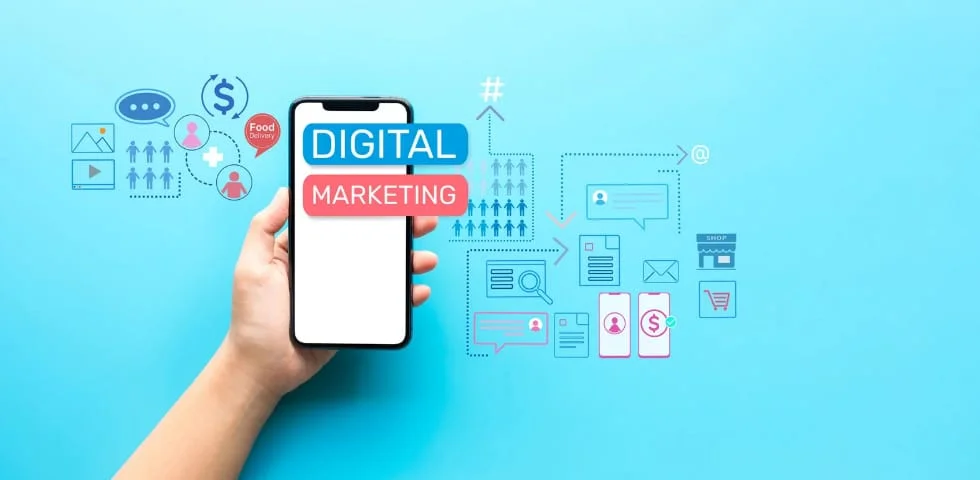Introduction
In the fast-paced world of digital marketing, staying ahead of the curve is not just an advantage—it’s a necessity. The landscape is constantly evolving, driven by new technologies, shifting consumer behaviors, and the increasing importance of data privacy. As we move into 2024, understanding the latest trends and innovations is crucial for marketers aiming to maintain a competitive edge and connect with their audiences more effectively.
Over the past few years, digital marketing has undergone significant transformations. From the rise of artificial intelligence (AI) to the dominance of video content, these changes have reshaped how businesses approach their marketing strategies. With new trends emerging, it’s essential to keep up with the developments that will define the industry in the coming year.
This blog post will explore the top digital marketing trends and innovations to watch in 2024. We’ll delve into how AI is revolutionizing marketing, the growing impact of voice search, the expansion of social commerce, and much more. Whether you’re a seasoned marketer or a business owner looking to optimize your strategies, this guide will provide you with the insights you need to stay ahead in 2024.
Overview of the Current Digital Marketing Landscape
The digital marketing landscape has never been more dynamic, with rapid advancements in technology and shifting consumer expectations constantly reshaping the industry. In recent years, the explosion of data, the widespread adoption of smartphones, and the omnipresence of social media have driven a significant transformation in how businesses engage with their customers.

Data-Driven Marketing Dominance
Today, data is the backbone of digital marketing. Marketers are increasingly relying on data analytics to make informed decisions, personalize customer experiences, and optimize campaigns. The ability to collect, analyze, and act on vast amounts of consumer data allows businesses to tailor their messaging and reach the right audience at the right time.
Omnichannel Marketing and Customer Experience
Consumers now interact with brands across multiple channels, from social media and websites to mobile apps and physical stores. This shift has given rise to omnichannel marketing, where creating a seamless and consistent customer experience across all touchpoints is essential. Companies that successfully integrate their marketing efforts across channels are seeing higher engagement, better customer retention, and improved ROI.
The Evolving Role of Content
Content remains king in digital marketing, but the type of content that resonates with audiences is changing. While long-form articles and blogs are still valuable, there’s a growing preference for visual content like videos, infographics, and interactive experiences. Additionally, the rise of user-generated content and influencer marketing continues to influence how brands communicate their messages.
As we delve into the specific trends and innovations for 2024, it’s important to understand how these overarching changes have set the stage for the next wave of digital marketing strategies.
Key Digital Marketing Trends to Watch in 2024
As we look ahead to 2024, several key trends are poised to shape the future of digital marketing. These trends reflect the ongoing evolution of technology, shifts in consumer behavior, and the increasing importance of data privacy. By understanding and leveraging these trends, marketers can stay ahead of the competition and deliver more personalized, engaging experiences to their audiences.

Trend 1: AI-Powered Marketing
Artificial intelligence (AI) continues to revolutionize digital marketing by enabling hyper-personalization, predictive analytics, and automation at scale. AI-powered tools can analyze vast amounts of data to predict consumer behavior, optimize content, and automate customer interactions. In 2024, we can expect AI to play an even more significant role in areas like:
- Personalized Content Creation: AI tools like GPT-4 and other advanced algorithms are helping marketers create tailored content that resonates with specific audience segments. This allows for more effective targeting and improved engagement rates.
- Customer Journey Optimization: AI can track and analyze customer behavior across multiple touchpoints, enabling marketers to deliver the right message at the right time, enhancing the overall customer journey.
- Chatbots and Virtual Assistants: The use of AI-driven chatbots and virtual assistants will continue to grow, providing instant, personalized support to customers and freeing up human resources for more complex tasks.
Trend 2: Voice Search Optimization
With the proliferation of voice-activated devices like Amazon Alexa, Google Assistant, and Apple Siri, voice search is rapidly becoming a dominant mode of online search. This shift is forcing marketers to rethink their SEO strategies. In 2024, optimizing for voice search will be crucial as consumers increasingly use spoken queries to find information.
Natural Language Processing (NLP): Marketers must focus on long-tail keywords and conversational phrases that match how people speak, not just how they type.
Featured Snippets and Answer Boxes: Optimizing content to appear in featured snippets, which often serve as the source for voice search answers, will be key to capturing voice-driven traffic.
Trend 3: Video Marketing Dominance
Video continues to reign as the most engaging form of content, with platforms like YouTube, TikTok, and Instagram leading the charge. In 2024, video marketing will dominate digital strategies, with short-form videos, live streaming, and interactive video content taking center stage.
- Short-Form Video: Platforms like TikTok and Instagram Reels have popularized short-form videos, making them a powerful tool for brand storytelling and audience engagement.
- Interactive Video: Interactive videos, where viewers can click, swipe, or make choices within the video, are gaining traction as they offer a more engaging and personalized experience.
- Live Streaming: Live video continues to grow in popularity, particularly for product launches, Q&A sessions, and behind-the-scenes content that fosters real-time interaction with audiences.
Trend 4: Social Commerce Expansion
Social media platforms are increasingly integrating e-commerce features, blurring the lines between social interaction and shopping. Social commerce is becoming a critical channel for brands, especially as consumers become more comfortable making purchases directly within social media apps.
Shoppable Posts: Instagram, Facebook, and Pinterest now allow users to purchase products directly from posts, making the buying process seamless and convenient.
Influencer Partnerships: Collaborating with influencers to promote products through social commerce channels is becoming a more prevalent strategy for driving sales and reaching new audiences.
Trend 5: Privacy-First Marketing
With the introduction of stricter privacy regulations like GDPR and CCPA, consumers are becoming more aware and protective of their data. This shift is forcing marketers to adopt privacy-first strategies that prioritize transparency and consumer consent.
Data Minimization: Collecting only the data that is necessary and being transparent about its use will be critical for building trust with consumers.
Cookie less Future: As third-party cookies phase out, marketers will need to explore alternative ways to track and target users, such as first-party data collection and contextual advertising.
These trends are setting the stage for a new era in digital marketing, where technology, data, and consumer trust will play pivotal roles. By embracing these changes, marketers can stay ahead of the curve and continue to drive successful campaigns in 2024.
Innovations in Marketing Technology (MarTech)
As digital marketing becomes increasingly complex, the tools and technologies that marketers rely on are evolving at a rapid pace. In 2024, innovations in Marketing Technology (MarTech) will play a crucial role in helping businesses streamline their operations, enhance customer experiences, and drive more effective campaigns. Here are some of the most significant MarTech advancements to watch:

Advanced Analytics and Predictive Modeling
In the era of big data, the ability to analyze and interpret vast amounts of information is a game-changer. Advanced analytics tools are enabling marketers to gain deeper insights into customer behavior, predict future trends, and make data-driven decisions with greater accuracy.
Predictive Analytics: By using machine learning algorithms, predictive analytics tools can forecast customer behaviors, such as purchase likelihood, churn rates, and lifetime value. This allows marketers to tailor their strategies to target high-value customers more effectively.
Real-Time Analytics: The demand for real-time data analysis is growing, as marketers seek to respond to customer interactions instantly. Real-time analytics platforms provide immediate insights, enabling quick adjustments to campaigns and improving responsiveness.
Marketing Automation and Workflow Optimization
Automation continues to be a driving force behind more efficient and scalable marketing operations. In 2024, we’ll see even more sophisticated automation tools that can handle complex tasks, freeing up marketers to focus on strategy and creativity.
AI-Driven Automation: Beyond simple tasks like email marketing, AI-driven automation can now manage entire customer journeys, from lead nurturing to post-purchase follow-ups. These tools can dynamically adjust messaging based on real-time customer interactions.
Cross-Channel Campaign Management: New MarTech platforms are making it easier to manage campaigns across multiple channels, ensuring consistency and coherence in messaging. This is particularly important for omnichannel marketing strategies where seamless customer experiences are essential.
Customer Data Platforms (CDPs)
As privacy regulations tighten, the way businesses collect and manage customer data is changing. Customer Data Platforms (CDPs) are emerging as essential tools for unifying customer data from various sources while ensuring compliance with data privacy laws.
- Unified Customer Profiles: CDPs create a single, comprehensive view of each customer by integrating data from different touchpoints. This enables more personalized marketing and improved customer segmentation.
- Data Security and Privacy: CDPs are designed with privacy in mind, ensuring that customer data is handled securely and in compliance with regulations like GDPR and CCPA. This helps build trust with consumers while still enabling effective marketing.
Content Experience Platforms (CXP)
Content continues to be at the heart of digital marketing, but delivering the right content to the right audience at the right time is becoming increasingly challenging. Content Experience Platforms (CXPs) are helping marketers optimize content delivery and improve engagement.
- Personalized Content Delivery: CXPs use AI and machine learning to deliver personalized content experiences based on user behavior, preferences, and context. This ensures that each customer receives content that is relevant to their needs and interests.
- Dynamic Content Creation: Some CXPs offer tools for creating dynamic content that can change in real-time based on the user’s interactions or location. This helps keep content fresh and engaging, driving higher conversion rates.
Blockchain in Digital Marketing
While still in its early stages, blockchain technology is beginning to make its mark on digital marketing, particularly in areas like transparency, fraud prevention, and data security.
- Transparent Advertising: Blockchain can provide transparency in digital advertising by creating an immutable record of transactions. This helps combat ad fraud and ensures that advertisers are getting what they pay for.
- Secure Data Sharing: Blockchain’s decentralized nature offers a secure way to share data between parties, reducing the risk of breaches and ensuring data integrity.
The rapid evolution of MarTech is empowering marketers to do more with less, improving efficiency, and enabling more personalized and effective campaigns. By embracing these innovations, businesses can stay ahead in the competitive digital landscape of 2024.
The Role of AI and Machine Learning in Digital Marketing
Artificial intelligence (AI) and machine learning (ML) are no longer just buzzwords in the digital marketing industry—they are integral components that are transforming how marketers understand and interact with their audiences. In 2024, the influence of AI and ML will only grow, driving more personalized, efficient, and data-driven marketing strategies. Here’s how these technologies are shaping the future of digital marketing:

Hyper-Personalization Through AI
One of the most significant impacts of AI in digital marketing is its ability to enable hyper-personalization. Unlike traditional personalization methods that rely on broad demographic data, AI analyzes individual behaviors, preferences, and interactions to create highly tailored marketing experiences.
- Dynamic Content Personalization: AI can dynamically adjust website content, emails, and advertisements to align with the specific interests and behaviors of each user. For example, an e-commerce site can display personalized product recommendations based on a visitor’s browsing history and past purchases.
- Predictive Customer Segmentation: AI algorithms can identify patterns within large datasets, enabling marketers to segment audiences more precisely. Predictive analytics then allows for targeting these segments with content and offers that are most likely to resonate with them, increasing conversion rates.
Enhanced Customer Journey Mapping
Understanding and optimizing the customer journey is crucial for any marketing strategy. AI and ML are making it easier to map out the entire customer journey, from initial awareness to post-purchase, and optimize each touchpoint for better engagement and conversion.
- Journey Orchestration: AI can track a customer’s journey across multiple channels and predict the next best action for each stage. This means marketers can automatically serve up the right content, offers, or messages at the right time, improving the overall customer experience.
- Behavioral Analysis: Machine learning models can analyze vast amounts of behavioral data to identify trends and predict future actions. For instance, AI can predict when a customer is likely to churn and trigger targeted retention campaigns.
AI-Driven Content Creation
While human creativity is irreplaceable, AI is becoming a valuable tool in content creation. AI-powered tools can generate content that resonates with specific audiences, freeing up marketers to focus on strategy and creative direction.
- Automated Content Generation: AI tools like OpenAI’s GPT models can create blog posts, product descriptions, and social media updates based on input data. While these tools are not yet perfect, they can significantly reduce the time and effort required to produce high volumes of content.
- Content Optimization: AI can also optimize content for SEO by suggesting keywords, analyzing readability, and predicting how well a piece of content will perform based on past data. This ensures that the content not only engages the audience but also ranks well in search engines.
Advanced Predictive Analytics
Predictive analytics, powered by machine learning, allows marketers to forecast outcomes and trends with greater accuracy. This capability is becoming increasingly important for making data-driven decisions and staying ahead of the competition.
- Customer Lifetime Value (CLV) Prediction: AI can predict the future value of a customer based on their past interactions, allowing businesses to focus their resources on high-value customers. This is crucial for long-term profitability and customer retention strategies.
- Campaign Performance Forecasting: By analyzing historical data, AI can predict how future marketing campaigns are likely to perform. This helps marketers allocate budgets more effectively and optimize campaigns before they even launch.
AI in Customer Service and Support
AI is also transforming customer service by providing faster, more efficient support through chatbots and virtual assistants. These AI-driven tools are becoming increasingly sophisticated, capable of handling complex queries and offering personalized assistance.
- Chatbots and Virtual Assistants: Modern chatbots can simulate human conversation, resolve issues, and provide product recommendations 24/7. These tools improve customer satisfaction by providing instant support, reducing wait times, and handling inquiries outside of business hours.
- Sentiment Analysis: AI can analyze customer interactions, such as social media posts or customer service chats, to gauge sentiment. This allows businesses to quickly identify and address potential issues, improving overall customer satisfaction.
As AI and machine learning continue to advance, their applications in digital marketing will become even more powerful and sophisticated. By leveraging these technologies, marketers can create more personalized, predictive, and efficient campaigns, driving better results and building stronger connections with their audiences.
Impact of Privacy Regulations on Marketing Strategies
In recent years, privacy concerns have become a central issue in digital marketing, driven by the introduction of stringent data protection laws like the General Data Protection Regulation (GDPR) in Europe and the California Consumer Privacy Act (CCPA) in the United States. As these regulations evolve and expand globally, marketers must adapt their strategies to comply with new standards while still delivering personalized and effective campaigns.

Understanding Key Privacy Regulations
Privacy regulations like GDPR and CCPA have fundamentally changed how businesses collect, store, and use consumer data. These laws are designed to give consumers more control over their personal information and to ensure that companies handle data responsibly.
- GDPR (General Data Protection Regulation): Implemented in 2018, GDPR is a comprehensive data protection law that applies to all companies operating within the European Union (EU) or handling the data of EU citizens. It requires businesses to obtain explicit consent before collecting personal data and to provide clear information on how that data will be used.
- CCPA (California Consumer Privacy Act): Similar to GDPR, the CCPA grants California residents the right to know what personal information is being collected about them, to whom it is being sold, and to request the deletion of their data. Businesses must also provide a clear “Do Not Sell My Personal Information” option on their websites.
These regulations have set a precedent for other regions, leading to the development of similar laws worldwide. As a result, marketers must be proactive in ensuring their practices align with these regulations.
Adapting Marketing Strategies for Privacy Compliance
With the growing emphasis on data privacy, marketers must find new ways to deliver personalized experiences while respecting consumer privacy. This requires a shift in how data is collected, managed, and used in marketing campaigns.
- Data Minimization: To comply with privacy laws, marketers should adopt a data minimization approach, collecting only the data that is necessary for their marketing efforts. This not only reduces the risk of non-compliance but also builds trust with consumers who are increasingly wary of how their data is used.
- First-Party Data Collection: As third-party cookies are phased out, first-party data (information collected directly from customers through owned channels) becomes more valuable. Marketers should focus on building direct relationships with their audience, using tactics like email sign-ups, loyalty programs, and direct interactions to gather data with explicit consent.
- Transparency and Consent Management: Being transparent about data collection practices and obtaining explicit consent from users is crucial. Marketers should implement clear, easy-to-understand consent mechanisms on their websites and provide users with options to control their data, such as opting out of data collection or adjusting privacy settings.
The Rise of Cookie less Tracking Solutions
With the impending demise of third-party cookies, which have long been a cornerstone of digital advertising, marketers need to explore alternative tracking and targeting solutions that comply with privacy regulations.
- Contextual Advertising: Instead of relying on user-specific data, contextual advertising targets ads based on the content a user is viewing. This approach aligns with privacy regulations and can be just as effective in delivering relevant ads without infringing on user privacy.
- Server-Side Tracking: Server-side tracking involves collecting data directly from the server, bypassing the need for third-party cookies. This method allows for more accurate data collection while maintaining user privacy.
- Identity Resolution: Identity resolution technologies allow marketers to build unified customer profiles by linking data from different sources while respecting privacy laws. These profiles can then be used for personalized marketing without relying on third-party cookies.
Building Trust Through Ethical Data Practices
In a world where consumers are increasingly concerned about their privacy, building trust is essential for any brand. Ethical data practices not only ensure compliance with regulations but also enhance the brand’s reputation and foster long-term customer relationships.
- Clear Privacy Policies: A transparent and easy-to-understand privacy policy is a must-have for any business. It should clearly outline what data is collected, how it is used, and the rights of the consumer regarding their data.
- Consumer Education: Educating consumers about their privacy rights and how their data is used can help build trust. Brands that are proactive in explaining their data practices and offering control to their customers are more likely to earn loyalty.
- Data Security: Ensuring that consumer data is stored securely and protected from breaches is critical. Marketers should work closely with their IT teams to implement strong data security measures and respond quickly in the event of a breach.
As privacy regulations continue to evolve, marketers must remain vigilant and adaptable, embracing new strategies that prioritize consumer privacy without sacrificing the effectiveness of their campaigns. By doing so, they can build stronger, more trustworthy relationships with their audiences while staying ahead of the regulatory curve.
Case Studies of Successful Marketing Campaigns
Examining real-world examples of companies that have successfully leveraged the latest digital marketing trends provides valuable insights into how these strategies can be implemented effectively. In this section, we’ll explore two case studies that highlight the impact of AI-powered marketing and voice search optimization.

Case Study 1: AI-Powered Marketing at Netflix
Overview: Netflix, a leader in the entertainment industry, has mastered the art of AI-powered marketing to drive customer engagement and retention. With over 230 million subscribers globally, Netflix leverages AI to create personalized experiences that keep users coming back.
Challenge: As a subscription-based service, Netflix’s success depends on keeping its subscribers engaged and reducing churn. To achieve this, Netflix needed to offer content recommendations that align closely with individual preferences, ensuring that users always find something they want to watch.
Solution: Netflix implemented a sophisticated AI-powered recommendation system that analyzes vast amounts of user data, including viewing history, search behavior, and even the time of day users watch content. The AI algorithms then generate personalized content suggestions tailored to each user’s unique preferences.
Dynamic Personalization: Netflix’s AI system constantly updates recommendations in real-time, adapting to changes in user behavior. This level of personalization keeps the content experience fresh and relevant, which is crucial for retaining subscribers.
Content Curation: AI also helps Netflix decide what new content to produce and promote. By analyzing viewing patterns, Netflix can predict what types of shows and movies will be popular with its audience, guiding its content creation strategy.
Results: The AI-driven recommendation engine is responsible for over 80% of the content watched on Netflix. This high level of engagement has significantly reduced subscriber churn and has positioned Netflix as a pioneer in using AI for customer retention.
Takeaway: AI-powered personalization is a powerful tool for increasing customer satisfaction and loyalty. By leveraging AI to understand and anticipate customer needs, brands can deliver more relevant and engaging experiences, driving long-term success.
Case Study 2: Voice Search Optimization at Domino’s Pizza
Overview: Domino’s Pizza, a global leader in the fast-food industry, has embraced voice search optimization to make ordering pizza as convenient as possible for its customers. By integrating voice technology into its marketing strategy, Domino’s has enhanced the customer experience and increased sales.
Challenge: As consumer behavior shifts towards more hands-free, convenient methods of interacting with brands, Domino’s recognized the need to simplify the ordering process. With the rise of voice-activated devices like Amazon Alexa and Google Assistant, the company sought to capitalize on this trend.
Solution: Domino’s developed a voice-activated ordering system that allows customers to place orders using their smart speakers. The system is integrated with Domino’s existing online ordering platform, enabling customers to reorder their favorite pizzas or customize new orders through voice commands.
Voice-Friendly Interface: The system was designed to understand natural language, making it easy for customers to place orders conversationally. Domino’s also optimized its website and mobile app for voice search, ensuring that customers could easily find information like store locations, menus, and promotions using voice queries.
Marketing Integration: To promote the new voice-ordering feature, Domino’s launched a marketing campaign that highlighted the convenience of ordering through voice assistants. This included social media ads, email marketing, and partnerships with smart speaker providers to reach a broader audience.
Results: The voice-activated ordering system has been a hit with customers, contributing to a significant increase in online orders. Domino’s has reported that voice orders now account for a growing percentage of its total sales, underscoring the effectiveness of this strategy.
Takeaway: As voice search continues to grow in popularity, brands that optimize their digital presence for voice interactions will be better positioned to capture customer interest. Domino’s success demonstrates how voice search optimization can enhance the customer experience and drive sales.
All these case studies illustrate the tangible benefits of adopting cutting-edge digital marketing strategies. By leveraging AI and voice search optimization, companies like Netflix and Domino’s have not only improved customer engagement but also set themselves apart as leaders in their industries.
Predictions for the Future of Digital Marketing Beyond 2024
As we look beyond 2024, the digital marketing landscape is expected to undergo further significant transformations. Emerging technologies, evolving consumer behaviors, and the continuous push for privacy and transparency will shape the future of marketing. Here are some key predictions for where digital marketing is headed in the coming years.

1. The Rise of Augmented Reality (AR) and Virtual Reality (VR) in Marketing
Augmented Reality (AR) and Virtual Reality (VR) are poised to become mainstream tools in digital marketing, offering immersive experiences that engage consumers on a whole new level. These technologies will be used to create interactive and personalized customer experiences, particularly in e-commerce and retail.
- Virtual Shopping Experiences: AR and VR will allow consumers to virtually try on clothes, preview how furniture looks in their homes, or even test drive a car—all from the comfort of their own space. This level of interactivity will reduce the friction in the buying process and increase conversion rates.
- Immersive Brand Experiences: Brands will use AR and VR to create memorable, immersive experiences that resonate with consumers. For example, virtual tours, 360-degree videos, and interactive storytelling will become common marketing tactics to captivate and engage audiences.
2. Increased Adoption of Blockchain for Transparency and Trust
Blockchain technology, known for its transparency and security, will see broader adoption in digital marketing, particularly in areas like advertising, data security, and supply chain transparency.
- Ad Fraud Prevention: Blockchain can help combat ad fraud by providing a transparent ledger of advertising transactions. This ensures that marketers only pay for genuine impressions and clicks, improving the efficiency and trustworthiness of digital advertising.
- Consumer Data Ownership: With blockchain, consumers could gain more control over their data, choosing who can access it and being compensated for sharing it. This shift could lead to a more ethical approach to data collection and use, aligning with growing privacy concerns.
3. Evolution of AI into Autonomous Marketing Systems
Artificial intelligence will continue to advance, moving beyond just assisting marketers to taking on more autonomous roles in decision-making and campaign management.
- Autonomous Campaign Management: AI systems will be able to manage entire marketing campaigns with minimal human intervention, from strategy formulation to execution and optimization. These systems will learn from past campaigns to continuously improve performance, allowing marketers to focus more on strategy and creativity.
- Emotionally Intelligent AI: Future AI systems may be capable of understanding and responding to human emotions, enabling more empathetic and personalized interactions with customers. This could revolutionize customer service and engagement, making AI-driven communication feel more human.
4. The Growth of the Metaverse as a Marketing Platform
The metaverse, a virtual, interconnected digital space where users can interact with each other and digital objects in real time, is set to become a significant marketing platform. As more consumers spend time in the metaverse, brands will have new opportunities to engage with their audiences in creative and immersive ways.
- Virtual Events and Experiences: Brands will host virtual events, such as product launches, concerts, and meet-and-greets within the metaverse, allowing for global participation without geographical constraints.
- Digital Goods and NFTs: The sale of digital goods and non-fungible tokens (NFTs) within the metaverse will open up new revenue streams for brands. Exclusive digital products, such as virtual fashion items, art, or branded experiences, will become a key part of digital marketing strategies.
5. Continued Emphasis on Ethical Marketing and Sustainability
As consumers become more conscious of environmental and social issues, ethical marketing and sustainability will continue to gain importance. Brands that prioritize transparency, sustainability, and social responsibility will resonate more with consumers and build long-term loyalty.
- Sustainable Marketing Practices: Companies will increasingly adopt sustainable marketing practices, such as reducing carbon footprints, using eco-friendly materials, and promoting circular economies. These efforts will be highlighted in marketing campaigns to attract eco-conscious consumers.
- Social Responsibility and Cause Marketing: Brands will continue to align themselves with social causes, using their platforms to advocate for issues like diversity, inclusion, and environmental protection. Consumers will expect companies to take a stand on these issues and will reward those that do with their loyalty.
6. Hyper-Personalization through Quantum Computing
While still in its infancy, quantum computing holds the potential to revolutionize digital marketing by enabling hyper-personalization on an unprecedented scale. Quantum computers could analyze and process vast amounts of data far more quickly than today’s systems, allowing for real-time personalization across all channels.
- Real-Time Personalization at Scale: Quantum computing could allow marketers to deliver personalized content and offers in real-time, based on an individual’s immediate context, behavior, and preferences, across multiple platforms simultaneously.
- Enhanced Predictive Analytics: The advanced processing power of quantum computers will significantly enhance predictive analytics, enabling marketers to forecast trends and consumer behavior with greater accuracy and at a faster pace.
As these predictions unfold, the future of digital marketing promises to be more technologically advanced, consumer-centric, and ethically driven. Marketers who stay ahead of these trends and adapt their strategies accordingly will be well-positioned to succeed in the rapidly evolving digital landscape.
Tools and Resources for Staying Updated with Industry Trends
In the fast-evolving world of digital marketing, staying updated with the latest trends, tools, and best practices is essential for maintaining a competitive edge. Marketers need to continually educate themselves and adapt to changes in the industry. Below are some of the most valuable tools and resources to help you stay ahead of the curve in 2024 and beyond.
1. Industry Blogs and Websites
Regularly reading industry blogs and websites is one of the best ways to stay informed about the latest developments in digital marketing. These sources provide a wealth of information, from trend analysis and expert opinions to case studies and actionable tips.
- Moz Blog: A go-to resource for SEO and inbound marketing, offering insights into the latest trends in search engine optimization, link building, and content marketing.
- HubSpot Blog: HubSpot covers a wide range of digital marketing topics, including inbound marketing, sales, customer service, and more, making it a comprehensive resource for marketers at all levels.
- Neil Patel Blog: Renowned marketer Neil Patel provides practical advice on SEO, content marketing, social media, and analytics, along with tools and strategies to boost online visibility.
- Content Marketing Institute (CMI): Focused on content marketing, CMI offers in-depth articles, research, and guides to help marketers create and distribute valuable, relevant content.
2. Podcasts and Webinars
Podcasts and webinars offer a convenient way to learn from industry experts while on the go or during your workday. These resources often feature interviews with thought leaders, deep dives into specific topics, and discussions on emerging trends.
- Marketing Over Coffee: A weekly podcast that discusses marketing tactics and strategies with industry experts, covering everything from SEO and social media to AI and analytics.
- The Content Strategy Podcast: Hosted by Kristina Halvorson, this podcast features interviews with content strategists and marketing professionals, focusing on best practices in content creation and management.
- SEMrush Webinars: SEMrush offers regular webinars on a variety of digital marketing topics, including SEO, PPC, content marketing, and social media. These webinars are led by industry experts and provide actionable insights.
- HubSpot Academy: HubSpot offers free webinars and courses on inbound marketing, sales, and customer service, providing marketers with the tools and knowledge they need to excel in their roles.
3. Online Courses and Certifications
Investing in online courses and certifications is a great way to deepen your knowledge and gain new skills in specific areas of digital marketing. These credentials can also boost your professional credibility and open up new career opportunities.
- Google Digital Garage: Offers free online courses on a range of digital marketing topics, including SEO, analytics, and online advertising. Completing these courses can help you stay current with Google’s best practices.
- HubSpot Academy: Provides free certifications in inbound marketing, content marketing, email marketing, and more. These courses are designed to equip marketers with the skills they need to succeed.
- Coursera: Partnering with top universities and companies, Coursera offers a variety of digital marketing courses, including specializations in data analytics, social media, and marketing automation.
- LinkedIn Learning: Offers a wide range of courses in digital marketing, covering everything from the basics to advanced techniques. LinkedIn Learning also provides certifications that can be displayed on your LinkedIn profile.
4. Industry Conferences and Networking Events
Attending industry conferences and networking events is invaluable for keeping up with trends, learning from experts, and connecting with peers in the marketing community. Many conferences also offer virtual attendance options, making it easier to participate from anywhere in the world.
- Content Marketing World: One of the largest content marketing conferences globally, offering sessions on the latest strategies, tools, and trends in content marketing.
- Inbound: Hosted by HubSpot, Inbound is a premier event that brings together thousands of marketing professionals to discuss the future of inbound marketing and customer experience.
- Social Media Marketing World: A must-attend event for social media marketers, offering insights into the latest social media trends, tools, and best practices.
- Web Summit: One of the world’s largest tech conferences, Web Summit covers a wide range of topics, including digital marketing, AI, and innovation. It’s a great place to learn about the future of marketing and technology.
5. Newsletters and Industry Reports
Subscribing to newsletters and reading industry reports can keep you informed about the latest research, trends, and innovations in digital marketing. These resources often provide data-driven insights that can help guide your marketing strategies.
- MarketingProfs: Offers a newsletter that covers a wide range of marketing topics, including strategy, content marketing, and analytics. Their in-depth reports provide valuable insights into industry trends.
- eMarketer: Provides comprehensive research and reports on digital marketing trends, including data on consumer behavior, ad spending, and technology adoption.
- Think with Google: Google’s newsletter offers insights and research on the latest trends in consumer behavior, digital marketing, and technology, helping marketers stay informed about the future of the industry.
- The Moz Top 10: A biweekly newsletter from Moz that curates the best articles, guides, and research in the digital marketing world. It’s a great way to stay updated with minimal effort.
By leveraging these tools and resources, you can stay ahead of the latest trends and continuously refine your marketing strategies. The digital marketing landscape is always evolving, and staying informed is key to maintaining a competitive edge.
Conclusion
The digital marketing landscape is in a constant state of flux, driven by rapid advancements in technology, changing consumer behaviors, and evolving regulatory environments. As we move into 2024 and beyond, staying ahead of the latest trends and innovations will be crucial for marketers who want to maintain a competitive edge and deliver value to their audiences.
From the rise of AI-powered marketing and voice search optimization to the increasing importance of privacy-first strategies and the growing role of the metaverse, the future of digital marketing promises to be both challenging and exciting. By embracing these trends and continuously adapting to the ever-changing environment, marketers can create more personalized, efficient, and impactful campaigns that resonate with their audiences.
Moreover, as digital marketing continues to evolve, the importance of ongoing education and staying informed cannot be overstated. Leveraging the right tools, resources, and networks will be essential for keeping up with industry developments and ensuring that your strategies remain effective and forward-thinking.
Ultimately, the key to success in digital marketing lies in a willingness to innovate, experiment, and learn. By staying agile and open to new ideas, marketers can navigate the complexities of the digital landscape and achieve sustainable growth in the years to come.













